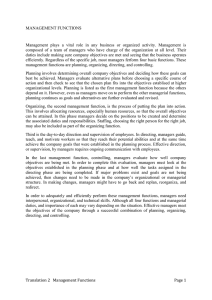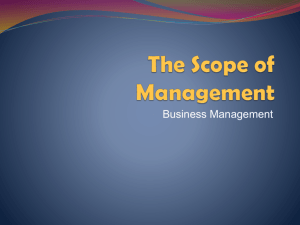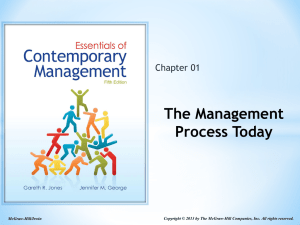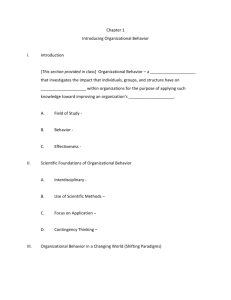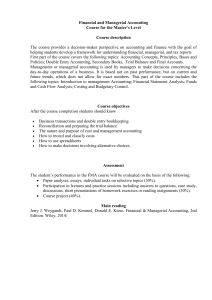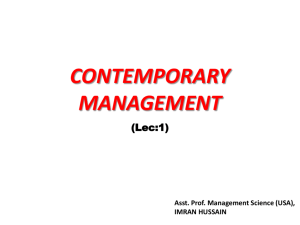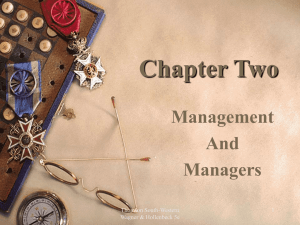Laboratory Management
advertisement
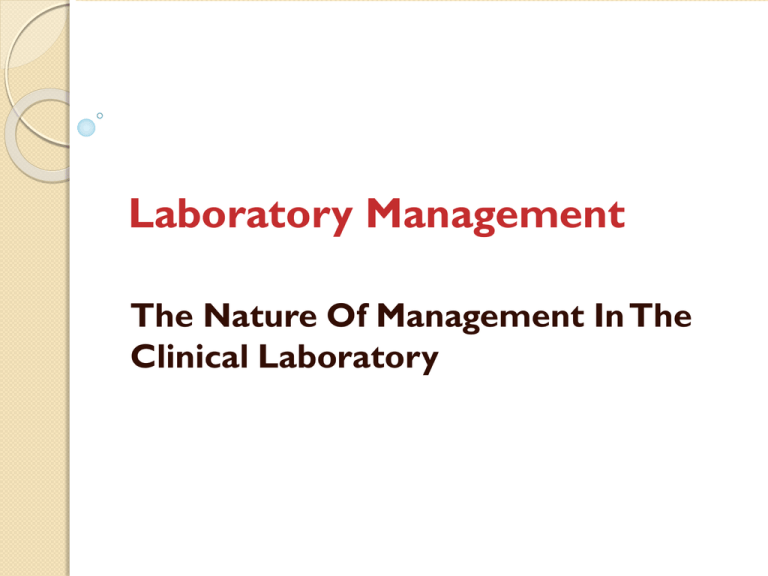
Laboratory Management The Nature Of Management In The Clinical Laboratory Introduction Medical Laboratory Services (Laboratory results) are essential to all aspects of health care and they should be: • accurate, • reliable, • and timely 2 Introduction 3 70% of clinical medicine decision making is predicated upon, or confirmed by medical laboratory test results In the United States there are between 7 and 10 billion laboratory tests reported annually Introduction If inaccurate results are provided, the consequences can be very significant including: ◦ ◦ ◦ ◦ ◦ 4 Unnecessary treatment Treatment complications Failure to provide the proper treatment Delay in correct diagnosis Additional and unnecessary diagnostic testing Management and communication skills of laboratory directors, supervisors and technologists Complex interdigitation of expertise in Medical areas Technical areas Scientific areas Efficient operation of a clinical laboratory 5 Effective delivery of medical laboratory services to clinicians and their patients Introduction The efficient operation of a clinical laboratory and the effective delivery of medical laboratory services to clinicians and their patients require a complex interdigitating of expertise in medical, scientific and technical areas Although the medical, scientific, and technical expertise are essential pre-requisites for the provision of medical laboratory service, success in applying these techniques to benefit patient care is vitally dependent on: ◦ the management and communication skills of laboratory directors, supervisors and technologists 6 Laboratory Management Laboratory management task is to integrate and coordinate organizational resources so that quality laboratory services can be provided as effectively and efficiently as possible ◦ Organizational resources include personnel, equipment, money, time and space 7 Management: Art or Science Management is indeed a science ◦ There are precise elements, scientific and exact aspects that have to be learned and assimilated Any manager must have: ◦ A good knowledge of certain quantitative methods and analysis of financial and statistical data ◦ As well as certain, less scientific but well tried and tested elements such as: human motivations, and the effect of different payment systems on the performance of different occupations 8 Management: Art or Science Management is also an art in the sense that: o There is great room for the use of creativity, imagination, o o 9 initiative and invention within the overall sphere of the occupation It includes skills that can not be measured as in other applied sciences like chemistry, physics and medical sciences Includes communication skills, motivation and directives Management: Art or Science Thus, management can be considered as both a science and an art The successful management of today’s clinical laboratory, like any other organization or institution, requires: ◦ A vast array of skills ◦ Founded on rigorous principles of management science 10 Definitions of Management It is very difficult to give a precise definition of the term ‘management’. 1. Management involves the coordination and integration of resources to accomplish specific results 2. Management is a social process comprising a series of actions that lead to the accomplishment of objectives 3. Management is defined as “Getting from where we are to where we want to be with the least expenditure of time, money and effort” 11 Definitions of Management Management is the universal process of efficiently getting activities completed with and through other people Another definition which was formulated on consensus is: 4. ◦ 12 Management is the guiding of human and physical resources into dynamic organization units that achieve their objectives to the satisfaction of those served and with a high degree of morale and sense of attainment on the part of those rendering the service Definitions of Management The definition contains four basic elements: ◦ ◦ ◦ ◦ 13 Toward objectives Through people Using techniques In an organization Definitions of Management 14 Toward objectives Through people Using techniques In an organization ◦ Goals and purposes consistent with efficient delivery of laboratory services for quality healthcare. ◦ Guiding "leading and directing" in such a manner that these professional laboratory technicians feel a sense of responsibilities and attainment "achievement" ◦ Physical resources such as laboratory equipment, computers, space and so forth ◦ Into dynamic organizational units implying division of labor, specialization, protocols and procedures, and functional processing units Definitions of Management It must be pointed out that management is an activity, it is not letting each day take care of itself, and rather it is making things happen Too often laboratory managers fall into the trap of "fighting fires" on daily basis For management to be effective, and to ensure efficient operation of the laboratory ◦ it must be in control, ◦ planning ahead the steps 15 Descriptive Administration Model Human 16 Laboratory managers are entrusted with three categories of resources (inputs): Financial ◦ operating and capital budget Physical ◦ space, equipment and supplies Human ◦ technical and support staff 17 As a result of the managerial role and fulfilling certain functions ◦ planning, organizing, leading and evaluating Three categories of output are expected: ◦ satisfactory performance, ◦ products- laboratory reports to the physician when needed – ◦ and self-serving behavior-a sense of accomplishment among the staff doing the work 18 There are many external and organizational forces that influence the administration process in any given institution e.g. politics, power, conflict resolution Managerial Duties and Responsibilities A director directs the affairs of an organization by establishing goals and priorities that determine the direction the organization will take ◦ The director might not directly supervise in a technical sense, since his role is primarily one of broad policy making An administrator administers or runs an organization within the framework of the various directives and policies given to him ◦ He is not the person who establishes the larger goals, but a technician who knows how to make the organization move efficiently, to achieve its purpose 19 Managerial Duties and Responsibilities A manager takes charge of the management or oversees the functioning of an activity to achieve a set goal or purpose ◦ his strength is in his ability to use all of these resources to get things done properly 20 A supervisor oversees the activities of others to help them accomplish specific tasks or to perform scheduled activities efficiently Distinction of three levels in the management team of the laboratory Laboratory directors and administrators ◦ Retain ultimate responsibility in achieving goals e.g. changes in technology, capital investments, and services rendered are finalized by this level of laboratory management Laboratory managers or chief technologist ◦ They create and maintain an environment for laboratory professionals to function efficiently. ◦ They plan, organize, direct, and control jobs. Laboratory supervisors ◦ They focus on people and operational delivery of laboratory services. 21 Distinction of three levels in the management team of the laboratory ◦ The bench – level supervisor duties Exercise a large numbers of technical skills in the performance of laboratory testing Examples instrument repair troubleshooting new procedure selection development 22 Leadership skills needed at various managerial levels Management Levels Skills needed المهارات االنسانية Technical Supervisory Technologist Interpersonal Manager\ Chief Technologist Conceptual Laboratory director Administrator Leadership skills needed at various managerial levels The laboratory director or administrator exercises fewer technical skills, rather, the emphasis shifts at this level to conceptual skills such as: ◦ Long – range planning ◦ Goal setting ◦ Innovating in response to change 24 Leadership skills needed at various managerial levels The administrative or chief technologist in the middle is required to exercise skills in both the technical and conceptual areas All three levels of laboratory management need to be equally clever in interpersonal skills ◦ Human relations skills in a laboratory are of critical importance to managerial effectiveness 25 The clinical laboratory is staffed by a wide variety of backgrounds and educational preparation, from units clerk through doctorate – levels The cohesion of this group as a healthcare team is essential for effective management The clinical laboratory administrator is a manager of professionals Laboratory supervisor manages things but leads people 26 The Administrative Process Laboratory management is to integrate and coordinate resources toward accomplishment of goals The task is thus a process comprising a series of actions 27 Planning of Activities Planning of activities is the key function of managers at all levels where both long – range and short range plans are drawn up. Long – range planning is concerned with growth potential ◦ e.g. the director may wish to bring in house a battery of analyses previously sent to a reference laboratory. His planning steps would include: identifying sufficient equipment, space and personnel, a series of written protocols and procedures, cost – per test analysis, and so forth. Short – range planning includes setting specific objectives to aid in reaching long – range goals. All levels of laboratory management should be involved in various phases of both long and short – range planning. 28 Most management failure is due to failure in communication Organizing The organizing function involves developing structure to facilitate the coordination of resources to achieve completion long and short – range planes. Division of labor is to be created. Working relationships must be outlined to include lines of authority and workflow for the optimal functioning of the interrelated units 29 Directing The directing function is the managerial leadership. Managers in the clinical laboratory are concerned with the human element. Successful managerial leadership creates a climate in which both the needs of the individual and the goals of the organization can be met. 30 Controlling The wrap–up function in the administrative process is controlling which ensures that the end-product of organized and directed events conforms to plans Supervisors are aware of importance of good quality control In the administrative process controlling is important including: ◦ defining standards ◦ criteria for acceptable performance, ◦ developing reporting system, ◦ and taking corrective action when and where needed 31 Clinical Laboratory Administration Model 32 Decision – Making Decision – making is an activity that is inherent in all other administrative process activities This is the part of the process that ties everything together Decisions must be made as part of planning, organizing, directing and controlling The process includes: ◦ problem analysis, ◦ development and analysis of alternative course of action ◦ and decision implementation and control 33 Cost–effective Management Cost–effective management of clinical laboratories must be considered Laboratory managers are called upon to: ◦ accurately forecast cost/benefit ratios and market to new entities Managers must modify the structure for efficiency and redesign jobs, perhaps creating career ladders for technical staff To increase productivity under the directing function, managers need to create a work environment characterized by responsibility and participative management Under controlling function, Laboratory managers must implement cost- containment measures through: ◦ reduction in overuse of testing, ◦ And inventory control 34 Making The Transition To Laboratory Management One of the most difficult obstacles for the new manager or supervisor is the transition from staff responsibilities to administrative responsibilities This transition includes a shift in the focus from direct service responsibility to new relationships, new responsibilities of managing versus doing and a new kingdom of influence (leadership). 35 Dual Hierarchy In Hospitals 36 The medical staff of the hospital “physicians” who were the users of hospital services, including the laboratory, formed into a separate organization with an independent, but also an interdependent, relationship to the administrative structure of the hospital, thus creating a dual hierarchical structure. Hospital administration is primarily concerned with providing safe and efficient care for all of its patients On the other hand, the major role of the medical staff is to ensure the quality of care for the individual patient 37 Dual Hierarchy In Hospitals 38 Under the new administrative pattern, the medical directors of the professional service departments (radiology, anesthesiology and pathology “laboratory medicine”) are responsible to the governing board through the executive committee of the medical staff for all professional (medical care) activities. At the same time they are also responsible to the hospital administrative hierarchy, which may be concerned with the management and fiscal issues of their departments, such as the laboratory, than in direct care to the individual patient This may place the medical director in a conflict situation, attempting to be responsive to the needs of the medical staff, which is primarily concerned with quality of patient care and outcomes, as well as to management demands of hospital administration.
